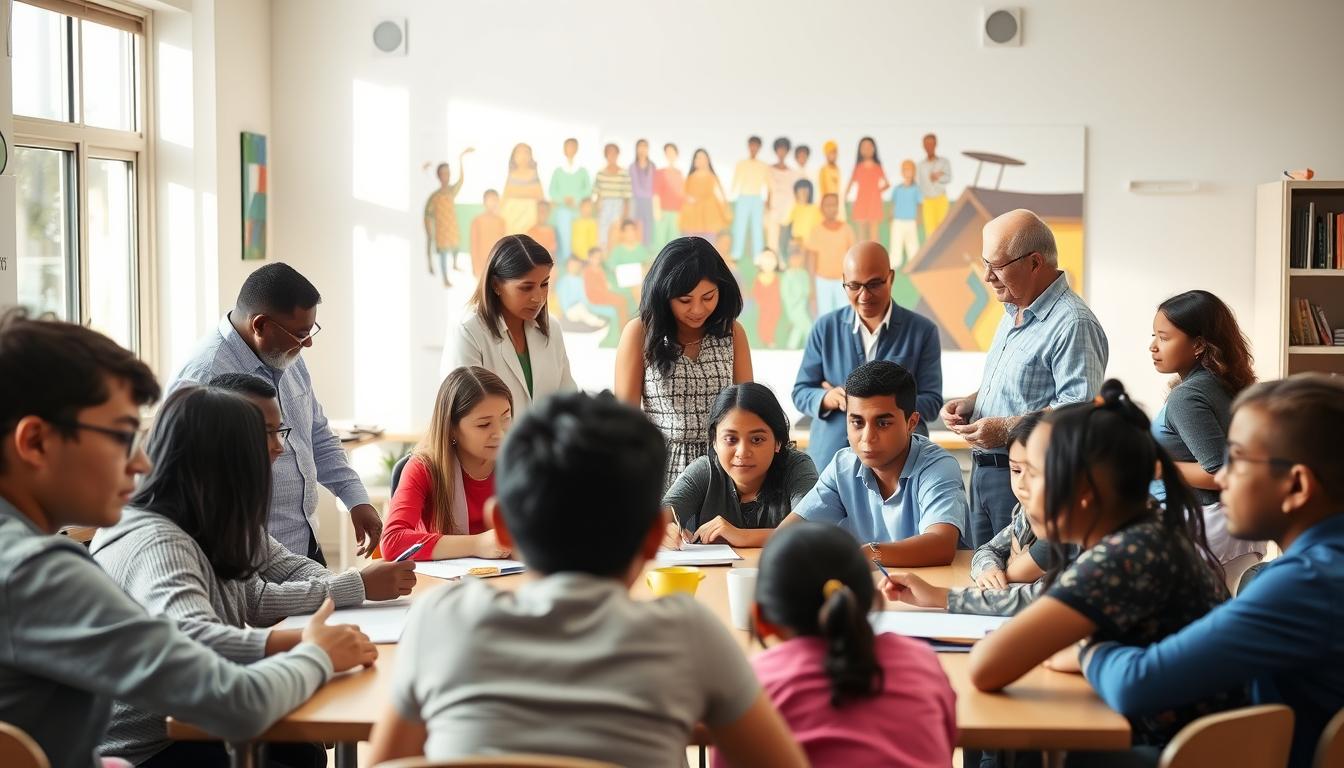Finding Scholarships: How Immigrants Can Access Educational Funding
Getting educational funding is key for immigrants wanting to study in the United States. Scholarships are crucial, offering financial help to students facing special challenges. By looking into the scholarship world, immigrants can find college scholarships that fit their needs.
This article is a detailed guide. It covers the resources, rules, and tips to find and apply for educational funding for immigrants. It aims to help immigrants find the support they need to pursue their academic goals.
Understanding the Landscape of Scholarships in the U.S.
Scholarships are key for students to fund their education. In the U.S., there are different types of scholarships. Each type meets different needs and qualifications. Knowing these categories helps immigrants find the right financial aid.
Types of Scholarships Available
There are mainly two types of scholarships: merit-based and need-based. Merit-based scholarships reward students for their achievements in academics, arts, or sports. These scholarships are given by schools, organizations, and private groups. They can greatly lower the cost of education.
Need-based scholarships help students who need financial aid. They look at how much money a family can afford. This scholarship type aims to cover the cost of education.
Eligibility Requirements
Eligibility for scholarships depends on their type. Merit-based scholarships need a good academic record and sometimes a portfolio or audition. Need-based scholarships look at family income and financial documents.
Immigrants should know about their residency status. Some scholarships require citizenship. Using scholarship resources can improve your chances of getting funding.
Key Challenges Faced by Immigrants
Immigrants face big hurdles when trying to get educational funding. They often struggle with the scholarship application process. These challenges add stress and limit their access to financial aid.
Language Barriers
Language issues are a big problem for many immigrants. Not knowing English well can make it hard to fill out applications right. It can also lead to mistakes that keep them from getting scholarships.
Financial Constraints
Money problems are another big challenge. Many immigrants can’t afford application fees or prep classes. This makes it hard for them to go to college and get the financial help they need.
Lack of Guidance
Finding scholarships can be tough, especially for those new to the system. Without help, immigrants might miss out on important financial aid. This lack of guidance can really limit their chances to go to college.
Researching Scholarship Opportunities
Finding the right scholarships takes careful research and smart strategies. By using the right methods, you can find many opportunities that match your needs. Two key ways to do this are by using online resources and connecting with local support groups.
Utilizing Online Resources
The internet has many tools to help find scholarships. Sites like Fastweb and Cappex have big databases. You can search by study area, location, and more. These sites make finding scholarships easier.
Keeping your profile up to date and using search alerts helps you find new opportunities. This way, you stay informed about scholarships that match your profile.
Networking with Community Organizations
It’s also crucial to connect with local groups. Nonprofits and cultural organizations offer specific help for scholarship seekers. They know about scholarships that aren’t well-known.
Building relationships with these groups can give you personal advice and support. They can help you through the scholarship application process.
Identifying Scholarships Specifically for Immigrants
Finding the right scholarships is key for immigrants going to college in the U.S. There are many funding options out there. Knowing the difference between national and local scholarships can really help. University scholarships are also a great option, as they often support immigrant students.
National vs. Local Scholarships
National scholarships reach out to students all over the country. They’re very competitive because lots of people apply. On the other hand, local scholarships are for specific areas or communities. This means fewer people apply, making it easier to get one.
Immigrants might do well to look for local scholarships. These can match their background or community involvement.
University-Specific Scholarships
Many colleges have special scholarships for immigrant students. These can offer a lot of money and are often less crowded. Schools look at their community’s needs and create scholarships for different students.
Looking into different universities and their scholarships can uncover great opportunities. It’s a way for immigrant students to get the financial help they need.
Preparing Scholarship Applications
When you start working on scholarship applications, getting ready is key. You can boost your chances by focusing on two main things. First, write a compelling personal statement. Second, get strong letters of recommendation from people who know you well.
Crafting a Compelling Personal Statement
Your personal statement is your chance to share your story and dreams. It’s where you tell about your experiences and why you want to go to school. A good personal statement shows what you’ve done and why you need help paying for school. Here’s how to make it stand out:
- Reflect on personal experiences that have shaped your goals and dreams.
- Clearly outline how the scholarship will help you achieve your future plans.
- Be sincere and authentic in sharing why you’re applying for the scholarship.
Importance of Letters of Recommendation
Letters of recommendation are very important for scholarship applications. They give a deeper look into your skills and character, beyond what your grades show. It’s best to ask people who know your strengths and accomplishments. Here’s how to ask for a letter:
- Choose teachers or community leaders who really know you.
- Give them a list of your achievements and goals.
- Give them enough time to write a thoughtful letter.
Financial Aid Resources Beyond Scholarships
Getting an education can be tough, but there are many ways to help. There are options beyond just scholarships. Knowing about these can really help with money problems.
Grants and Fellowships
Grants and fellowships give students money that they don’t have to pay back. This makes them a great choice. Students can look into grant opportunities from the government, non-profits, and private groups.
For example, the Pell Grant helps students who don’t have much money. It gives them a big break. Fellowships also help, offering chances to do research or get special training.
Work-Study Programs
Work-study programs are another great way to get help. They let students earn work-study financial aid while they’re in school. This helps with school costs and living expenses.
Students can find jobs that fit their school schedule. This way, they can apply what they learn in real life. Work-study also helps build skills for their future careers.
Applying for Multiple Scholarships
Applying for many scholarships can really help. It’s a smart way to get more financial aid. By applying to different scholarships, students can find more funding opportunities. This strategy also lets them show off their skills in different ways.
Benefits of a Diverse Application Strategy
Having a diverse application strategy has many benefits:
- It opens up more chances to get funding by applying to different scholarships.
- It helps avoid relying too much on one source of money.
- It improves your application skills, which helps for future scholarships.
Time Management Tips for Applications
Good time management is key for scholarship success. Here are some tips to stay on track:
- Make a calendar with all the scholarship deadlines.
- Divide the application process into smaller tasks.
- Set aside time for researching and writing each application.
- Check your progress often to meet all the requirements on time.
Understanding the Application Process
Getting to know the scholarship application process is key to getting funding. It’s important to understand what scholarships need and plan well for deadlines. Keeping track of these details helps you submit on time and meet all requirements.
Key Components of a Typical Application
A good scholarship application has several important parts. These parts show who you are and what you want to achieve. They usually include:
- Personal Statement: This part lets you share your goals and why you’re applying.
- Transcripts: These show your grades and what you’ve learned.
- Letters of Recommendation: Teachers or mentors can talk about your skills and character.
- Application Form: This is a basic form with your info and specific questions for the scholarship.
Deadlines and Tracking Applications
Being on time with scholarship deadlines is crucial. Use a calendar or apps to keep track of your applications. Here are some tips:
- Create a Timeline: List all deadlines and mark them in your planner.
- Utilize Apps: Apps can help you manage different scholarship applications.
- Regular Check-ins: Check your progress often to avoid missing anything.
How to Overcome Common Obstacles
Scholarship applications can be tough. It’s important to be resilient and get the right help. Focusing on rejection and mentor support can help immigrants succeed in their scholarship journey.
Dealing with Rejection
Getting rejected from a scholarship can be tough. It’s key to handle it well. Here are some tips:
- Reflect on Feedback: If you get feedback, use it to improve your next application.
- Understand the Competition: Remember, many people apply for a few spots. This can help you feel better.
- Maintain Motivation: Look for other scholarships or financial help to keep moving forward.
Seeking Support from Mentors
Mentors can be a big help in finding scholarships. They offer valuable advice. Here’s how to find one:
- Find a Mentor: Look for mentors in community groups or schools who know about scholarships.
- Participate in Workshops: Join workshops led by mentors to improve your application skills.
- Build a Strong Network: Use mentors to connect with others who can share scholarship tips and experiences.
The Role of Educational Institutions
Educational institutions play a key role in helping immigrants get higher education. They create programs and services to meet the challenges immigrants face. This helps create a better learning environment for them.
The main focus is on providing educational support for immigrants. This ensures they have the resources and guidance they need.
Support Services for Immigrants
Universities and colleges offer special support for immigrant students. They provide:
- Language assistance programs to improve communication skills.
- Cultural integration workshops to build a sense of community.
- Financial literacy sessions to manage finances for academic success.
These programs help students gain important skills. They also reduce stress from adapting to a new educational system.
Scholarship Advising Centers
Scholarship advising centers are vital for immigrant students. They help with the scholarship application process. These centers offer:
- Personalized scholarship advising to find the right funding opportunities.
- Workshops on application best practices, like essay writing and interview prep.
- Networking chances with alumni and professionals for valuable insights.
These centers greatly help immigrant students. They ensure students get the help they need to understand scholarship applications.
Success Stories: Immigrants Who Secured Funding
Immigrant success stories show the amazing journeys of students who won scholarships. These stories inspire and show how scholarships change their education and careers.
Case Studies of Successful Applicants
Many immigrants have achieved success with scholarships. For example, Maria, from Guatemala, got a scholarship that paid for her college. She graduated in engineering and now works at a top tech company.
Ahmed, from Syria, faced many challenges in his new country. But his hard work caught the eye of scholarship programs. He got to study medicine, thanks to scholarships.
Impact of Scholarships on Immigrant Students
Scholarships do more than just help with money. They boost confidence, community involvement, and grades. Students also get mentorship and job connections.
- Access to resources and support services enhances academic performance.
- Networking opportunities foster connections that are essential for career development.
- Financial relief reduces stress and allows students to focus on their studies.
These stories remind us of the big difference scholarships make. By supporting education, we help diverse people contribute to society.
The Future of Scholarships for Immigrants
The world of educational funding is changing fast. It’s key to keep up with trends that help immigrant students. Colleges and groups are now offering more scholarships to fit the diverse student body.
They’re not just opening up to more people. They’re also understanding the special hurdles immigrants face. This change is vital to make sure money helps those who need it most.
Trends in Educational Funding
More scholarships for immigrant students are popping up. This shows a big push for inclusivity in schools. Funding is coming from more places, like private companies, not just grants and government.
This means more chances for immigrant students to go to college. It also makes schools work harder to attract and support a wide range of students.
Advocacy for Broader Access
There’s a growing effort to get more money for education. People and groups are working together to make sure everyone knows about scholarships. They’re also pushing for better ways to fund education and more support for immigrant students.
This hard work is crucial. It helps make sure everyone has a fair shot at getting the money they need for school, no matter their immigration status.
FAQ
What types of scholarships are available for immigrants?
How can immigrants find scholarship resources?
Are there scholarships exclusively for undocumented students?
What are the common challenges faced by immigrants in securing scholarships?
How important are recommendation letters in scholarship applications?
What are the deadlines associated with scholarship applications?
Can financial aid for students include grants and fellowships?
What should an immigrant student include in their personal statement?
How can immigrants effectively manage their scholarship applications?
What role do educational institutions play in supporting immigrant students?
Published on: 5 de February de 2025

Luke Martin
Luke Martin, author of Credwallets.com, is a mathematics graduate with a specialization in financial markets. Known for his love of pets and his passion for sharing knowledge, Luke created the site to provide valuable insights into the complexities of the financial world. His approachable style and dedication to helping others make informed financial decisions make his work accessible to all, whether they're new to finance or seasoned investors.







